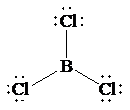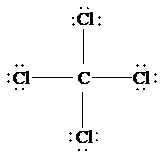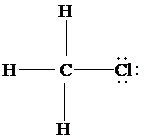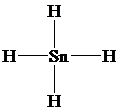
Concept explainers
Predict the bond angles for the following molecules:
Interpretation:
The bond angles of the given molecules are to be determined.
Concept introduction:
Electron domain is the number of bonds and lone pair of electrons around the central atom.
According to VSEPR, the electron domains repel each other and arrange themselves as far apart as possible in space.
Molecular geometry represents the arrangement of bonded atoms. If no lone pairs are present, then the molecular geometry is the same as the electron domain geometry.
The repulsion in lone pair–lone pair is greater than that in lone pair–bond pair, which in turn is greater than that in bond pair–bond pair. The repulsion due to a double bond is more than that due to single bonds.
Answer to Problem 75AP
Solution:
a)
b)
c)
d)
e)
f) Less than
g) Less than
h)
Explanation of Solution
a)
The Lewis structure of
is as follows:

In this structure, the
atom is bonded to two chlorine atoms by single bonds, and there is no lone pair on
atom. According to VSEPR, two electron domains are arranged on opposite sides to give a linear shape, with a bond angle of
b)
The Lewis structure of

In this structure, the
atom is bonded to three chlorine atoms by single bonds, and there is no lone pair on
atom. According to VSEPR, three electron domains are arranged in a trigonal planar shape with a bond angle of
c)
The Lewis structure of
is as follows:

In this structure, the
atom is bonded to four chlorine atoms by single bonds, and there is no lone pair on
atom. According to VSEPR, four electron domains are arranged in a tetrahedral shape with a bond angle of
d)
The Lewis structure of
is as follows:

In this structure, the
atom is bonded to three hydrogen atoms and one chlorine atom by single bonds, and there is no lone pair on
atom. According to VSEPR, four electron domains are arranged in a tetrahedral shape with a bond angle of
e)
The Lewis structure of
is as follows:

In this structure, each
atom is bonded to one chorine atom, and to each other. Thus, there are two electron domains around each
atom. Thus, the shape is linear with a bond angle of
f)
The Lewis structure of
is as follows:

In this structure, the
atom is bonded to two chlorine atoms by single bonds, and there is a lone pair on
atom. According to VSEPR, three electron domains are arranged in a trigonal planar shape with a bond angle of
atom, the shape of
is bent with a bond angle less than
g)
The Lewis structure of
is as follows:

In this structure, each
atom is bonded to one hydrogen atom, and to each other. There are two lone pairs on each oxygen atom. Thus, there are four electron domains around each oxygen atom. According to VSEPR, four electron domains have a tetrahedral shape. Due to the presence of two lone pairs, the shape is bent with a bond angle less than
h)
The Lewis structure is as follows:

In this structure, the
atom is bonded to four chlorine atoms by single bonds, and there is no lone pair on
atom. According to VSEPR, four electron domains are arranged in a tetrahedral shape with a bond angle of
Want to see more full solutions like this?
Chapter 9 Solutions
BURDGE CHEMISTRY VALUE ED (LL)
- Curved arrows are used to illustrate the flow of electrons. Using the provided starting and product structures, draw the curved electrons-pushing arrows for the following reaction or mechanistic step(s).arrow_forwardCurved arrows are used to illustrate the flow of electrons. Using the provided starting and product structures, draw the curved electron-pushing arrows for the following reaction or mechanistic step(s). Be sure to account for all bond-breaking and bond-making steps. I I I H Select to Add Arrows HCI, CH3CH2OHarrow_forwardCurved arrows are used to illustrate the flow of electrons. Use the reaction conditions provided and the follow the arrows to draw the intermediate and product in this reaction or mechanistic step(s).arrow_forward
- Curved arrows are used to illustrate the flow of electrons. Use the reaction conditions provided and follow the curved arrows to draw the intermediates and product of the following reaction or mechanistic step(s).arrow_forwardCurved arrows are used to illustrate the flow of electrons. Use the reaction conditions provided and follow the arrows to draw the intermediate and the product in this reaction or mechanistic step(s).arrow_forwardLook at the following pairs of structures carefully to identify them as representing a) completely different compounds, b) compounds that are structural isomers of each other, c) compounds that are geometric isomers of each other, d) conformers of the same compound (part of structure rotated around a single bond) or e) the same structure.arrow_forward
- Given 10.0 g of NaOH, what volume of a 0.100 M solution of H2SO4 would be required to exactly react all the NaOH?arrow_forward3.50 g of Li are combined with 3.50 g of N2. What is the maximum mass of Li3N that can be produced? 6 Li + N2 ---> 2 Li3Narrow_forward3.50 g of Li are combined with 3.50 g of N2. What is the maximum mass of Li3N that can be produced? 6 Li + N2 ---> 2 Li3Narrow_forward
- Concentration Trial1 Concentration of iodide solution (mA) 255.8 Concentration of thiosulfate solution (mM) 47.0 Concentration of hydrogen peroxide solution (mM) 110.1 Temperature of iodide solution ('C) 25.0 Volume of iodide solution (1) used (mL) 10.0 Volume of thiosulfate solution (5:03) used (mL) Volume of DI water used (mL) Volume of hydrogen peroxide solution (H₂O₂) used (mL) 1.0 2.5 7.5 Time (s) 16.9 Dark blue Observations Initial concentration of iodide in reaction (mA) Initial concentration of thiosulfate in reaction (mA) Initial concentration of hydrogen peroxide in reaction (mA) Initial Rate (mA's)arrow_forwardDraw the condensed or line-angle structure for an alkene with the formula C5H10. Note: Avoid selecting cis-/trans- isomers in this exercise. Draw two additional condensed or line-angle structures for alkenes with the formula C5H10. Record the name of the isomers in Data Table 1. Repeat steps for 2 cyclic isomers of C5H10arrow_forwardExplain why the following names of the structures are incorrect. CH2CH3 CH3-C=CH-CH2-CH3 a. 2-ethyl-2-pentene CH3 | CH3-CH-CH2-CH=CH2 b. 2-methyl-4-pentenearrow_forward
 Chemistry: Principles and ReactionsChemistryISBN:9781305079373Author:William L. Masterton, Cecile N. HurleyPublisher:Cengage Learning
Chemistry: Principles and ReactionsChemistryISBN:9781305079373Author:William L. Masterton, Cecile N. HurleyPublisher:Cengage Learning Chemistry: The Molecular ScienceChemistryISBN:9781285199047Author:John W. Moore, Conrad L. StanitskiPublisher:Cengage Learning
Chemistry: The Molecular ScienceChemistryISBN:9781285199047Author:John W. Moore, Conrad L. StanitskiPublisher:Cengage Learning Chemistry: An Atoms First ApproachChemistryISBN:9781305079243Author:Steven S. Zumdahl, Susan A. ZumdahlPublisher:Cengage Learning
Chemistry: An Atoms First ApproachChemistryISBN:9781305079243Author:Steven S. Zumdahl, Susan A. ZumdahlPublisher:Cengage Learning Chemistry: Principles and PracticeChemistryISBN:9780534420123Author:Daniel L. Reger, Scott R. Goode, David W. Ball, Edward MercerPublisher:Cengage Learning
Chemistry: Principles and PracticeChemistryISBN:9780534420123Author:Daniel L. Reger, Scott R. Goode, David W. Ball, Edward MercerPublisher:Cengage Learning




